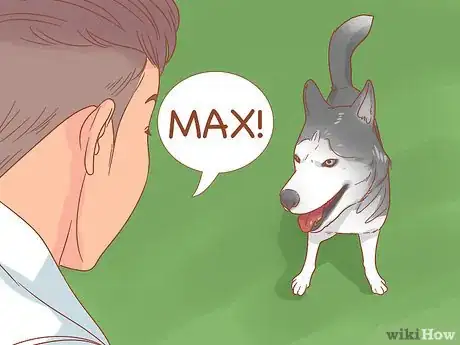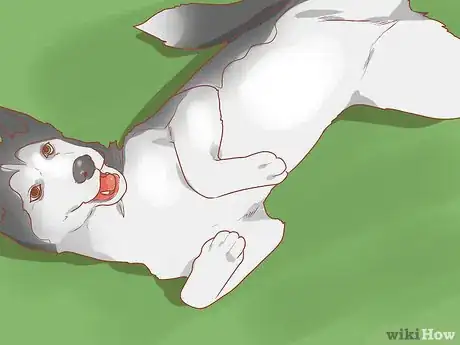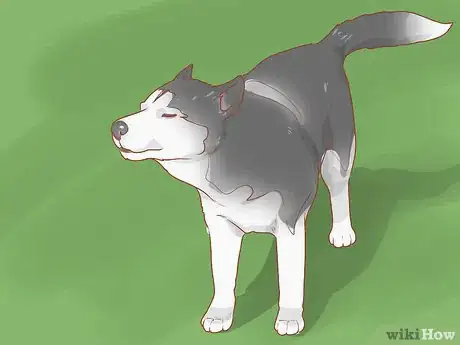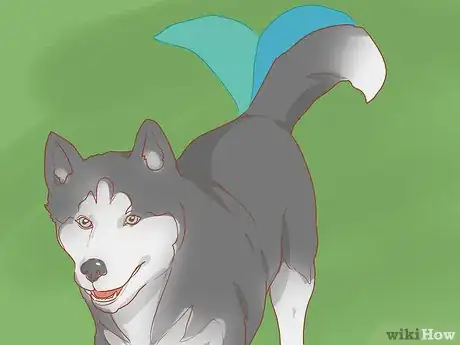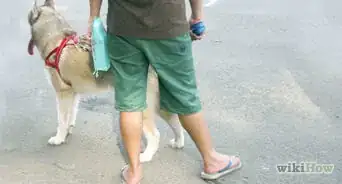This article was co-authored by David Levin. David Levin is the Owner of Citizen Hound, a professional dog walking business based in the San Francisco Bay Area. With over 9 years of professional dog walking and training experience, David's business has been voted the "Best Dog Walker SF" by Beast of the Bay for 2019, 2018, and 2017. Citizen Hound has also been ranked #1 Dog Walker by the SF Examiner and A-List in 2017, 2016, 2015. Citizen Hound prides themselves on their customer service, care, skill, and reputation.
There are 10 references cited in this article, which can be found at the bottom of the page.
This article has been viewed 61,219 times.
While you can’t actually carry on a full conversation with your dog, there are ways to effectively communicate with your pet. Talking with your pet is not only a lot of fun but will also strengthen the bond between you and your pooch. To talk to your dog, you need to train it and pay attention to the dog’s behavior. If you can train the dog to listen and pay attention to simple commands, it will actually listen to you when you talk.
Steps
Training a Dog to Listen
-
1Keep calm and stay relaxed. If you seem tense or agitated, your dog will take notice and will be much more likely to ignore your commands. Don’t stomp around or seem mad when you’re around your pet or it may get stressed out. You should also refrain from being anxious or overly energetic or it may be hard for your dog to calm down and listen.[1]
- If you need to calm down, you can do deep breathing exercises or meditate.
- Take a big, deep yawn to help calm your dog down if it’s excited or nervous.
-
2Train your dog to look at you. Say your dog’s name and look into its eyes when it looks at you. If your dog doesn't instinctively look at you when you call out its name, trace a line between its eyes and your eyes using your finger. The point of this exercise is to get your dog to pay attention to you when you call its name. Don't stare into your dog's eyes for too long because it could be interpreted as a sign of aggression.[2]
- You can draw the dog’s attention by holding a treat in the hand you’re using to signal the looking behavior. Show the dog the treat, then move it from in front of the dog's nose up to the bridge of your own nose.
- You may have to repeat this process 5-10 times until your dog understands.
- Stay consistent and don’t repeat the dog’s name more than once or it will get used to ignoring you.
Advertisement -
3Praise the dog in an upbeat voice once it makes eye contact. Immediately give your dog a treat and praise after it makes eye contact with you. This will train it to look at you when you call out its name, which will make it much easier to issue commands.[3]
- Once your dog learns to look at you, you can stop giving it treats every time.
- If a dog doesn’t pay attention to you while you’re talking, it won’t pay attention to the commands that you give it.
-
4Teach your dog how to sit. Teaching your dog to sit is one of the most important commands to teach it because it forces the dog to stop and pay attention to you. Say "sit" and wait for your dog to sit. If it does, reward it with a treat. If your dog isn’t naturally sitting, hold a treat behind the dog's head. This will force the dog to look behind itself and it will naturally sit down.[4]
- Immediately after the dog sits, make sure to reward it with praise or treats to reinforce the command.
- Once your dog learns to sit, you can train it to perform other commands.
Speaking to Your Dog
-
1Say your dog’s name before vocalizing a command. Saying your dog’s name will get its attention and will cause it to look in your direction. Start off all commands with its name to establish a pattern that they can follow in the future.[5]
-
2Stay consistent with your commands and don’t repeat yourself. Using different words for the same command will be confusing for your pooch. Use the same command every time when you want your dog to do something.[6]
- For instance, if you use the command “come” to have your dog come to you, don’t switch up your phrase and say “get over here,” or the dog may not understand.
- If you say “down” to command your dog to lie down, don’t use “down” when you want the dog to get off the furniture.
-
3Keep your commands short and simple. Your commands should be small, one-word increments that your dog can learn and understand. Use words like “stay,” “come,” and “sit.” These words have a distinct sound and won’t be confusing for your dog.[7]
-
4Pat the ground to tell your dog it’s time to play. Get down on all fours and hit the ground with your palms to let your dog know it’s time to play. This will get it into a fun mood and is a great way you can communicate with your dog using your body language.[9]
- If your dog doesn't understand that it's playtime, you can grab a toy to reinforce the message.
-
5Listen to the pitch of your dog’s bark. If your dog does a long, low-pitched bark, it likely means that they feel threatened or nervous. If the dog makes a short, high-pitched barking noise, it means that they are excited and happy to see you. Pay attention to your dog's bark to determine what mood it's in.[10]
-
6Pay attention to the dog's eyes. A dog will open its eyes wide when its feeling stressed or fearful. On the other hand, relaxed dogs will often squint and show little if any white in their eyes. Dilated pupils may also be a sign that the dog feels threatened or stressed.[11]
-
7Examine the dog's body language and tail. When a dog is in a playful mood it will bounce around and have exaggerated movements and facial expressions. An excited dog will typically wag its tail in a back and forth motion. On the other hand, an aggressive dog will stand up tall and look tense, with most of its weight distributed on all 4 legs or leaning slightly on its front legs.[12]
- A fearful dog will put its tail in between its legs and will often lean back, tremble, or roll on its side.
- Aggressive dogs may also wrinkle their muzzle or growl.
EXPERT TIPDavid Levin is the Owner of Citizen Hound, a professional dog walking business based in the San Francisco Bay Area. With over 9 years of professional dog walking and training experience, David's business has been voted the "Best Dog Walker SF" by Beast of the Bay for 2019, 2018, and 2017. Citizen Hound has also been ranked #1 Dog Walker by the SF Examiner and A-List in 2017, 2016, 2015. Citizen Hound prides themselves on their customer service, care, skill, and reputation.Professional Dog Trainer
 David Levin
David Levin
Professional Dog TrainerPay attention to your body language, as well. If you're not starting with body language, your verbal language isn't going to land. Try pretending you're speaking to someone who speaks only Russian. You can't use words alone; you have to show them what they mean. Then, they'll be able to learn the meaning of that word, and in the future they'll begin to understand it without the verbal display.
Community Q&A
-
QuestionWhy is my dog licking the air?
 CremelloHorseCommunity AnswerLicking the air can be a sign that you should check your pet's mouth to make sure there isn't an obstruction. He may also be licking the air if he has a loose tooth or other dental issues that are causing him pain. As dogs age, they can develop canine cognitive dysfunction, which is similar to Alzheimer's in humans.
CremelloHorseCommunity AnswerLicking the air can be a sign that you should check your pet's mouth to make sure there isn't an obstruction. He may also be licking the air if he has a loose tooth or other dental issues that are causing him pain. As dogs age, they can develop canine cognitive dysfunction, which is similar to Alzheimer's in humans.
References
- ↑ https://youtu.be/chLApH-WKl4?t=51
- ↑ https://youtu.be/oNhATwguJWA?t=189
- ↑ https://theconversation.com/how-to-talk-to-your-dog-according-to-science-71049
- ↑ https://www.petfinder.com/dogs/dog-training/talk-to-your-dog/
- ↑ https://youtu.be/chLApH-WKl4?t=46
- ↑ https://youtu.be/chLApH-WKl4?t=23
- ↑ https://theconversation.com/how-to-talk-to-your-dog-according-to-science-71049
- ↑ https://www.petcarerx.com/article/8-things-you-didnt-know-about-how-to-talk-to-your-dog/1462
- ↑ https://youtu.be/chLApH-WKl4?t=113
About This Article
If you want to talk to a dog, you'll need to train it to listen and look at you. To get your dog's attention, say your dog's name and look into its eyes when it looks at you. Make sure to praise your dog and give it a treat if you have one, so it learns to look at you whenever you call its name. Once your dog knows its name, you can start teaching it commands by first saying its name, then following with the command. Stay consistent and keep your commands short and simple, so your dog doesn't get confused. For more advice from our Veterinary co-author, including how to tell your dog's mood from its body language, scroll down!




